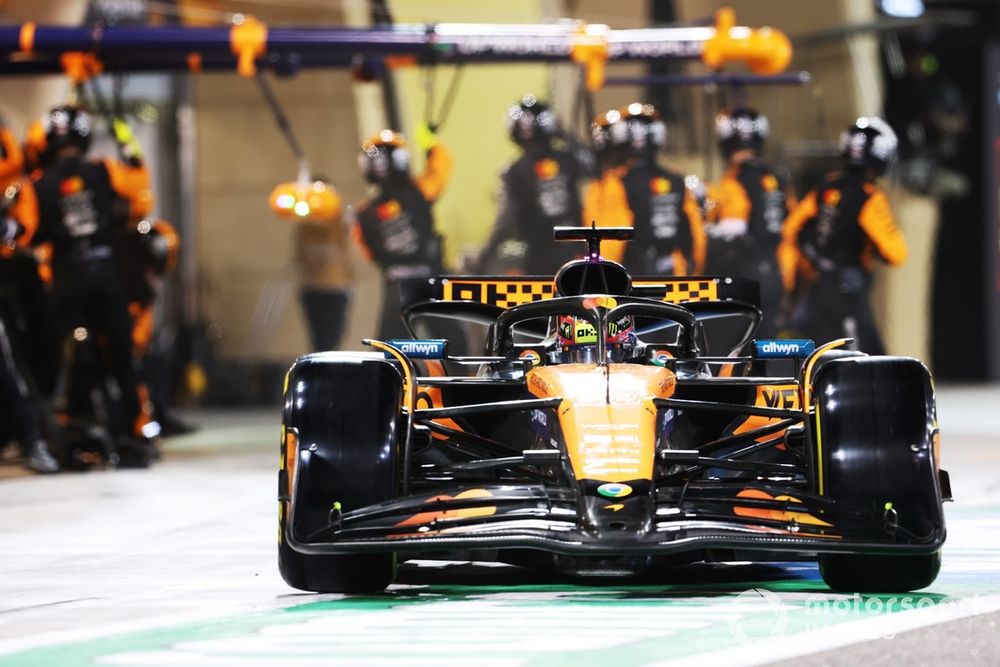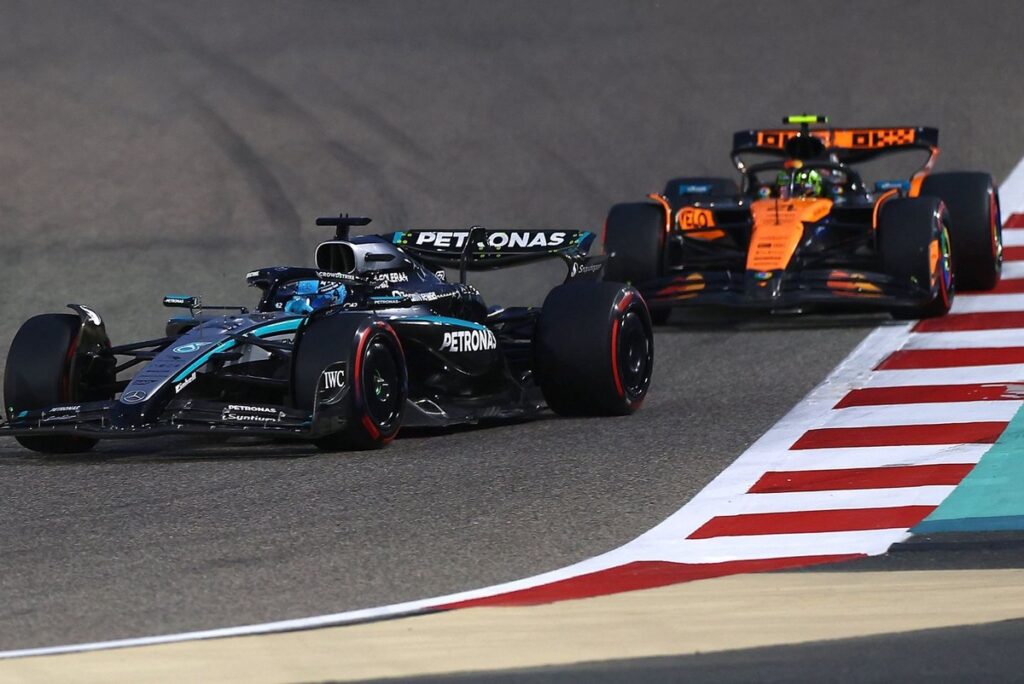High incidences of thermal degradation offered plenty of strategic variation at Formula 1’s Bahrain Grand Prix, as all three of Pirelli’s nominated tyre compounds came into play during the course of the race.
The C2 medium ended up being by far the most popular tyre used in the grand prix, having been responsible for 46% of the overall laps per Pirelli’s post-race data. The softs were marginally less popular than the hard tyre in terms of laps done, although all but five drivers started the race on the red-walled Pirellis.
But what was the fastest way to get around Bahrain, especially with the added variable of a safety car? There were about six or seven different strategies to follow, and not all of them created equally. The most common tyre progression in the race was soft-medium-hard, the latter necessitated by the timing of the safety car and dependent on what was left in each team’s allocation.
But it likely wasn’t the best strategy; although high degradation would suggest that the hard tyre would be the one to pick for the high-value race stint, the relatively low level of physical degradation meant that the softer tyres could be massaged into a longer stint. They’d start to lose performance by the end, but there was minimal evidence of graining or blistering that could prompt a desperate dash into the pits as the tyre surface opened up.
Opening with a soft-medium strategy – to undercut, or not to undercut?
For most of the grid, this was the game plan. The soft tyres had shown up well in FP2, as Pirelli’s revised construction of the C3 over the off-season had made it a little bit softer than last year’s compound but retained a similar level of degradation. The Italian rubber specialists predicted that the C3 might become more widely used in race strategy – and so it proved.
The key moment for the transition to mediums was in knowing when to perform the undercut. The sweet spot appeared to sit between laps 8-10, as this offered the most positional yield when the stops had cycled out.
With a two-lap undercut, this could offer about three-four seconds in your favour; so it proved for Esteban Ocon, who pitted from 12th and cycled out in sixth once everyone had made at least one stop. Ocon stopped at the end of lap eight, by no means the first driver to pit but the first to properly benefit from the undercut scenario. Nico Hulkenberg and Isack Hadjar had tried to drop theirs on laps five and six, but didn’t really get much out of it in the long run; Hadjar rose to 13th once the stops had cycled out, but he was already past the best of his medium tyres when others had emerged on brand new boots.
Ocon vaulted up the order with a perfectly timed stop
Photo by: Clive Mason – Getty Images
After the lap 8-10 purple patch for stops, stopping on lap 11 and 12 was considerably less auspicious. Yuki Tsunoda’s stop on lap 11 (albeit not helped by Red Bull’s malfunctioning traffic light system) cost about five seconds to Jack Doohan, who stopped two laps prior. As soft tyre degradation began to increase, the delta between old softs and new tyres also began to increase. Andrea Kimi Antonelli, who called in on lap 12 for the mediums, fell behind Max Verstappen despite the Red Bull driver remaining in his box for two extra seconds. The Dutchman had been over a second behind when he’d stopped on lap 10.
There’s the power of getting the undercut in early although, for Verstappen, it didn’t last particularly long. Instead of mediums, he’d tackled his middle stint on hards – and struggled to get much in the way of pace out of them. This ensured Antonelli didn’t have too long to wait before mounting a successful re-pass on the four-time champion.
Of course, the opposite approach applied – stretch out the soft stint, and then benefit later into stint two when everyone else’s tyres had cried enough. Oliver Bearman and Alex Albon both attempted this, opting to switch to hards for the middle stint after a 14- and 16-lap spell on the softs respectively.
In comparing Bearman’s hard-tyre pace to his team-mate’s medium pace, the Briton was moderately impressive on the hards. There was a distinct pace difference when Ocon had switched to mediums, and the Frenchman was about 1.5s-2s per lap quicker on that overlap phase. But he was seven laps into a medium stint by the time Bearman collected the hards, and thus the younger of Haas’ lanky driving duo was marginally quicker per lap.
The margin wasn’t huge: somewhere around 0.2-0.3s per lap on average. But, over the length of the stint, these little moments added up, bringing Bearman firmly into top 10 contention. Albon’s pace was slightly better than the Haas driver, ranging from the high 1m37s at the start of the stint to the low 1m39s versus Bearman’s low 1m38s-mid 1m39s. Had Albon not been stuffed by a double-stack pitstop, he might have been in with a shot of points…
Starting on mediums had the potential to work, but required patience. Luckily, Ferrari had exercised this (perhaps to the surprise of many, who consider the Italian team’s strategy work ropey at best) and stuck with its guns, ensuring both drivers could a) minimise the per-lap loss in time over the opening stint, and b) get to the middle stint later and instigate their own assaults for positions immediately.
Charles Leclerc and Lewis Hamilton did exactly that. On the mediums, Leclerc handily stayed in the 1m38s – matching the soft runners’ early pace, without the drop-off – and maintained it until stopping on lap 17 when he’d strayed into the 1m39s. With fresh mediums, he could immediately start turning in mid-1m37s when Norris was sitting in the high 1m37s-low 1m38s at that stage. Hamilton made similar progress, hacking his way through the upper midfield to bring himself into top five contention.
By contrast, the likes of Liam Lawson and Gabriel Bortoleto probably cut their medium-tyre starts too short to make the strategy work for them.
Mediums to medium: The race-winning strategy

Piastri’s double use of medium tyres to conclude the race proved to be the right call
Photo by: Steven Tee / Motorsport Images
Both McLarens opted for a double-medium pair of stints, as Oscar Piastri noted that the medium was “the one to be on” in the final stint. The sole non-McLaren driver to co-opt the strategy was Hulkenberg; although the Sauber racer was not in a position to be scoring points (and his disqualification for excessive skid block wear rendered his 13th-place finish obsolete), he found it was a very good tyre for the final stint.
Piastri and Lando Norris demonstrated (largely) what could be done with two different stances for the opening soft-to-medium transition. Norris pitted on lap 10, which would have offered undercut potential had he not had to serve a five-second penalty for his false start to the race. Through staying out longer on the softs, Piastri was lapping about a second slower than Norris on the new mediums, but he didn’t need to cover off his team-mate at that stage.
In that final stint, the mediums were the perfect middle-ground. George Russell, sitting between the McLaren duo, was tasked with bringing the softs to the end. He thought this “audacious” but nonetheless kept pace with Piastri in the early stages of the stint before degradation (and additional car woes) pulled the duo’s race laps apart.
Piastri managed his final stint through the low 1m35s to the low 1m36s, while Russell went through the 1m36s and out the other side to the 1m37s. From stint start to end, Russell encountered a 2.4s drop in laptimes; Piastri only 1.4s. The medium was unsurprisingly more consistent.
Hard tyres in the final stint were very hit or miss; both Ferrari drivers found the tyres were degrading over the stint without really having ever offered much of a chance to battle beyond the early laps. The likes of Ocon and Pierre Gasly also endured some drop-off – 1.7s over the stint for Gasly, about 1.6s for Ocon – but this was exacerbated by their need to battle Verstappen. They could ultimately do little against the Red Bull on medium tyres, although Gasly defended valiantly until he finally had to concede defeat on the final lap.
It seemed that the soft-medium-medium was the fastest way to get around, given the way the race played out. But, without the safety car, might anyone have dared to try the reverse strategy – front-load the medium stints, and end on softs for the final 10-15 laps? We’ll never truly know.
In this article
Jake Boxall-Legge
Formula 1
Be the first to know and subscribe for real-time news email updates on these topics
Subscribe to news alerts
Read the full article here

